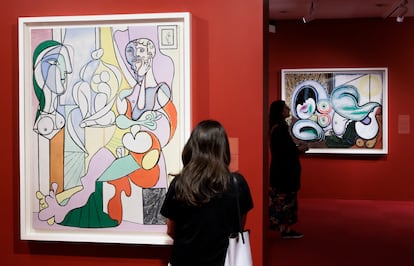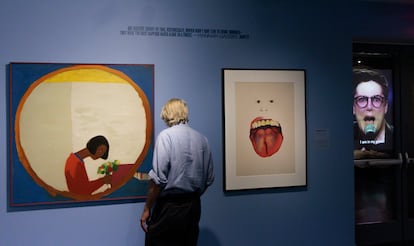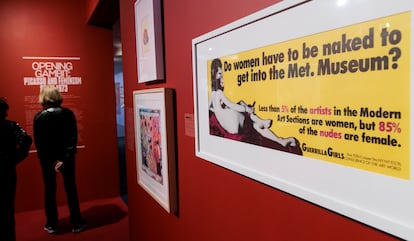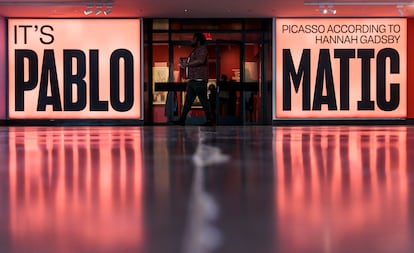Controversial feminist exhibit celebrates Picasso at Brooklyn museum on the 50th anniversary of his death
Comedian Hannah Gadsby is the show’s lead curator thanks to the success of a 2018 stand-up routine in which they slammed the Spanish painter


Interpreting Picasso in the context of Me Too is a bit of a stretch of the imagination. But of the many ways to commemorate the 50th anniversary of the death of Pablo Picasso (1881-1973), the Brooklyn Museum in New York has chosen a feminist interpretation. This exhibition sets the artist’s pictorial treatment of women — and Picasso’s misogyny — against the work of 30 women artists, pillars of feminist art (but not contemporaries of the painter who gave us Guernica. The result of the juxtaposition is the exhibition entitled It’s Pablo-matic [pun on ‘problematic’]: Picasso according to Hannah Gadsby. The Australian comedian rose to fame in 2018 with Nanette, their stand-up special (on Netflix) in which, among other issues, they slammed the artist and the patriarchal roots of art.
Gadsby, who studied art history but publicly rejected the discipline, “examines the artist’s complicated legacy from a critical, contemporary and feminist perspective,” the museum says. In their glosses and apostilles to the work on display — two dozen plates from the Vollard Suite and eight oil paintings, seven of them on loan from the Picasso Museum in Paris — the Australian artist starts from a categorical statement: “Picasso destroyed everything except the assumption of women as objects.” It is a sentence taken from Nanette, some of whose fragments can be seen on a loop in an adjoining room. In the installation’s audio guide, they are even more implacable: the creator, they come to say, is no longer only detestable for his misogyny, but also for his bad behavior and colonialist impulses. His inspiration from African art, his continuous return to classical mythology, would almost fall into the category of cultural appropriation, that other nefarious evil of the 21st century.

The exhibition is curated by two museum specialists, Catherine Morris, curator of the Center for Feminist Art —the only one of its kind in the US — and Lisa Small, head of European art, while the common thread corresponds to Gadsby, a professional “hater” of Picasso, as they defines themself in Nanette, so no one who visits the exhibition can be in any doubt. Well aware of their role as a feminist interpreter of this giant of the art world, their wit and the hypothetical invitation to humor one might expect from a professional comedian are overshadowed by their denial, proving to some that the worst thing that can happen to a comedian is to take themself seriously.
Quotes from other creators about Picasso’s political incorrectness (before the term had been coined) are dotted throughout the exhibition. “No one’s sexual fantasies are politically correct,” recalls visual artist Marilyn Minter, one of those who act as a counterweight to genius (and who nevertheless assumes the need to separate the artist from the man: “My thoughts about Picasso have changed as I learned more about him as a human. I still think he was undoubtedly a great artist, despite being a horrible man”). In the female affirmation display, dedications to Louise Bourgeois, Louise Nevelson, Cecily Brown, Kiki Smith and the anonymous collective Guerrilla Girls stand out. From the latter hangs a selection of his manifesto-works, such as the poster that reminds us that in the Metropolitan Museum of New York “less than 5% of the artists in the modern art sections are women, but 85% of the nudes are female.”
“This exhibition does not intend to cancel Picasso. You can’t cancel history,” says Morris to qualify the amendment that Gadsby has set out to make. “But its relevance to contemporary social, cultural and political priorities can be examined, and in doing so our understanding can be enriched by reflecting on new positions and viewpoints. Our exhibition aims to engage in a highly relevant discussion about the tensions between Picasso’s creative genius and the dubious power dynamics that defined the era in which he lived and worked.”

The exhibition, open through September 24, addresses complex issues surrounding misogyny, creativity, the canon of art history and the concept of genius. Also, the arsenal of accusations against the predatory Picasso, embodied in works such as Faun Uncovering a Sleeping Woman (Jupiter and Antiope, after Rembrandt), an aquatint from 1936 that belongs to the museum’s collection, or in the powerful exhibition of minotaurs that, in the light of this show, seem to be precursors of the alpha male. It also reviews his women, treated as muses as well as victims, especially Marie Thérèse Walter, who Gadsby reminds us was seduced by the painter when she was 17 when he had already turned 40, (the cartouche recalls that in France at that time the minimum age of consent was 13).
With Instagram and Twitter catchphrases (tags, slogans), Gadsby, who once equated Donald Trump, Harvey Weinstein and Picasso (“All three cut from the same cloth”), breaks down all the evils they blame on the artist, including his lack of skill as a sculptor or his gratuitous female nudes. Witty phrases like “If PETA couldn’t cancel Picasso, nobody can”, about the work Corrida: la mort de la femme torero (Bullfight: Death of a Female Bullfighter), from 1933, share space with obvious comments, like this one about a female nude belonging to the Vollard Suite, dated Paris, 1931: “It must have been very hot in Paris in the thirties.” There is a certain genital and anal fixation in the comments.

For all this, some critics, such as the New York Times and the specialist magazine ArtNews, have trashed the exhibition, and for its excesses that feel personal — Gadsby is so consumed with Picasso it is difficult to know where he begins and they end — among other criticisms. Others surrender to the provocative and stimulating eagerness of the comic’s gaze. Of the fifty or so exhibitions that will commemorate the figure of the painter throughout the year, this is by far the most daring, for its ability to generate heated opinions. But what else to expect, if not from the vision of someone who has said that Picasso “just put a kaleidoscope filter on his penis” when he was helping to forge cubism? The comedian succeeds in capturing their hatred for a “monumentally misogynistic and abusive domestic authoritarian dictator” who “occupies too much space” in the collective imagination of 20th century culture.
“Picasso once said that it took him four years to paint like Raphael, but a lifetime to paint like a child,” Gadsby writes in one of the wall texts. “Well, I don’t want to call myself a genius ..., but it only took me four years to be as funny as Raphael,” says Gadsby about a replica of the painting Great Bather with a Book (1937), made during their years as a student of art history. They later abandoned the degree (because of its patriarchal stamp) to which they now return on the wings of media success. Thanks to which, by the way, they have also managed to hang their own art in a museum, next to Picasso’s.
Sign up for our weekly newsletter to get more English-language news coverage from EL PAÍS USA Edition
Tu suscripción se está usando en otro dispositivo
¿Quieres añadir otro usuario a tu suscripción?
Si continúas leyendo en este dispositivo, no se podrá leer en el otro.
FlechaTu suscripción se está usando en otro dispositivo y solo puedes acceder a EL PAÍS desde un dispositivo a la vez.
Si quieres compartir tu cuenta, cambia tu suscripción a la modalidad Premium, así podrás añadir otro usuario. Cada uno accederá con su propia cuenta de email, lo que os permitirá personalizar vuestra experiencia en EL PAÍS.
¿Tienes una suscripción de empresa? Accede aquí para contratar más cuentas.
En el caso de no saber quién está usando tu cuenta, te recomendamos cambiar tu contraseña aquí.
Si decides continuar compartiendo tu cuenta, este mensaje se mostrará en tu dispositivo y en el de la otra persona que está usando tu cuenta de forma indefinida, afectando a tu experiencia de lectura. Puedes consultar aquí los términos y condiciones de la suscripción digital.
More information
Archived In
Últimas noticias
Maduro pleads not guilty before the federal court in New York: ‘I am still the president of Venezuela’
A new test can detect Alzheimer’s from a finger prick
UN team enters Sudanese city of El Fasher after paramilitary massacre: ‘It’s like a ghost town’
A recipe for resistance: Indigenous peoples politicize their struggles from the kitchen
Most viewed
- Gilles Lipovetsky: ‘If you want to live better and fall in love, take Prozac, don’t look to philosophy’
- Alain Aspect, Nobel laureate in physics: ‘Einstein was so smart that he would have had to recognize quantum entanglement’
- Alvin Hellerstein, a 92-year-old judge appointed by Bill Clinton, to preside over Maduro’s trial in New York
- Why oil has been at the center of Venezuela-US conflicts for decades
- Cuba confirms death of 32 of its citizens in the US attack against Venezuela










































